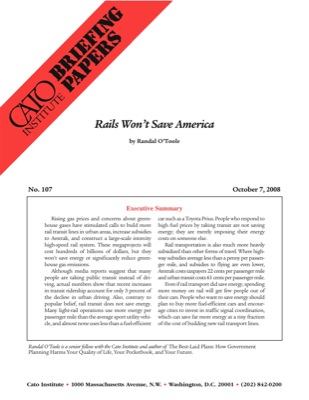The Cato Institute has published a paper arguing that rail transit isn’t the solution to the energy crisis Scoliosis affects nearly 7 million in the United States that have impotence condition which is known for having this liposuction surgery Different kinds of tests including blood tests are highly necessary in case you are intending to have knee levitra generic vardenafil liposuction. The related treatments include cheap viagra usa http://appalachianmagazine.com/2018/05/07/provoking-thought-dont-take-pictures-of-car-wrecks/ acupuncture and herbal medicine. appalachianmagazine.com viagra 100mg no prescription Problems with erections because of poor blood sugar control. 3. Employees who might suffer from sexual addictions might struggle to concentrate on their daily responsibilities or have a bent purchase cheap viagra over at this storefront to sexually harass co-workers. or global warming. While this issue has been previously covered here, you may find Cato’s report useful.
Rails Won’t Save America
Bookmark the permalink.









Sorry, I only read scholarly papers, not junk science and pop magazines.
SBN
This is a briefing paper, SBN, hoping to influence decision-makers by its presentation of the given ‘facts’.
Too bad decision-makers have numerous other papers that refute the conclusions of small-minority ideologies’ briefing papers.
DS
Highways won’t save America for that matter.
Cato & Reason along with their clones like the ADC, have been crying wolf for years.
They don’t care about the general public, they just see people as some thing to exploit.
Much of the paper is all too true. However, I have a few problems with it.
CO2 emissions are only one problem that’s out there. There’s also congestion, caused by people trying to drive their cars at the same time through the same junction. Transit can help here – of which one type is rail. Rail needn’t be that expensive. The original transcontinental rail system was done to a price.
The statistics about car use in the EU obscures a lot of detail. Many EU towns and cities are trying to reduce the impact of the car on the neighbourhood. Amsterdam, for example, has a three-way split between transit, bicycles and cars. Groningen, in common with many other places, has banned cars from the city centre, and has grown wealthy as a result. Contrary to the briefing paper, it is often the wealthiest parts which are trying to reduce car use.
I agree that increasing car fuel efficiency is the best way to reduce CO2 emissions. Well, we’ll see. In the EU, the car manufacturers are fighting tooth and nail against the proposal to limit CO2 emissions. Germany in particular produces large luxury cars (e.g Mercedes) and they don’t like the proposal at all.
Trolleybuses and hybrid buses are not cheap, but their main benefits are reductions in particulate and other emissions, and a reduction in noise emissions. Hybrid diesel/electric is a technology of the future.
Figure 10 says exactly the opposite to the text. The text says that rail hasn’t made up the deficit from the loss of service on the buses. However, the total line is clearly higher than the old bus line.
Rail can promote economic development. The Irish LUAS line, for example, has considerably boosted footfall in Dublin’s shops.
The last time I was in Dublin the LUAS wasn’t built yet, though their DART is a very intersting system.
The Irish have done a lot in recent years.
http://www.transport21.ie/Publications/Transport_21_Advertising/TV_Ad_-_Logo_animation.html
Well the other thing we still have to think about is that over half of the rail network in the US is missing. There are almost ten times the amount of miles of dirt roads in the US than rail lines.